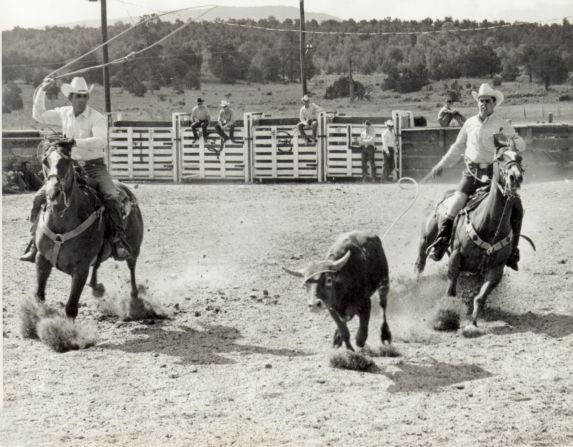Giles Lee grew up immersed in rodeo, as a ranch kid, a competitor, an organizer, a historian, and a fan. The Lovington, N.M. cowboy was born in Midland, Texas in 1922, the fourth child of Dick and Sarah Forrester Lee. When Giles was two, his dad and a partner bought a ranch in Lea County, New Mexico, and the family moved west.
Ranching, cowboying, and rodeo were all the Lee kids knew as they grew up. They helped out on the ranch, and Giles remembers their entertainment: cars parked in a circle to make an arena, with shotgun chutes and set-up pens.
Giles’ first time as a contestant in a formal rodeo setting was at the first Lea County Fair and Rodeo in 1935, where he and another rodeo legend, Tuffy Cooper, entered the junior calf roping.
His second time as a contestant was in 1938 in Midland. He placed high in the senior boys calf roping, winning a pair of boots and $150 cash, with the requirement that he had to write thank you notes to the sponsors!
The next time Giles got a taste of formalized rodeo was when he was a senior at Lovington High School. The intramural rodeo club at the junior college in Portales invited the seniors to rodeo with them. Giles didn’t have a way to get his little gray horse, Possum, to the rodeo. So “we borrowed a tiny little makeshift trailer somebody’d built, loaded ol’ Possum in this wooden trailer, and somewhere we got a pair of goggles to put on him.” Without a windshield, the horse needed protection for his eyes. Five seniors traveled together, in Giles’ father’s vehicle. “My dad had a little old Chevrolet coupe and we talked him into letting us drive that. Three of us sat in the front seat, and two sat in what they called the turtleneck, which raised up, in the back. It was quite a deal.” In Portales, they entered all the events they could. Giles and his friend Bill Spires won the wild cow milking and assumed they’d get prizes and buckles. But when they were called down to be introduced as winners, they each won a pair of socks and a necktie!
It was his first year of college at the New Mexico A&M (now New Mexico State) that Giles’ interest in organizing rodeo began. As a freshman in 1942, the University of Arizona had sent an
invitation to A&M to send a rodeo team. This begged the question: there was no rodeo team at A&M! Having a team required organization, officers, recognition from the college, sponsors, and someone to do the hard work of getting those things. With Giles as one of the thirteen team members, they got recognition from the administration and found sponsors: the Sheriff’s Posse and Paul Heffert’s Chevrolet garage, who provided two pickups and paid the bills for them.
The 1942 New Mexico A&M team traveled together, rode the same horses, used the same equipment, took bedrolls and slept in gyms at other universities. This was seven years before college rodeo had its official beginning with the NIRA. Then World War II interrupted, and contestants were thinned out as they either entered the service or were about to be drafted. Rodeos ceased, and Giles was called into duty. He joined the Army in 1943 and served three and a half years in the Army Air Corps as a Staff Sergeant and Crew Chief on B-17 aircraft in the Pacific.
When he came home, it was back to school, but “what I had on my mind was rodeo, not college,” he laughed. They put together another college rodeo team again in 1946. There were a lot of small time rodeos going on, what Giles calls “brush rodeos,” with makeshift arenas and whatever stock could be rounded up, in Arizona and Texas, and “I was doing more rodeoing than going to school,” he said. Then the “showdown” came: “We got to electing rodeo team members, and ol’ Giles was left out because I didn’t have a C average.” He couldn’t travel with the team. He finally improved his grades enough to go back to college rodeo. And chemistry was a problem. “I took it three times,” he recalled, and still couldn’t pass it. “I decided, that was it. No more college.” He went home to ranch.
During his college days, Giles began riding barebacks and bulls in addition to his roping. Bareback riding went pretty well: “I was coming along pretty good in the bareback horse riding, but was never much of a bull rider.” It was while he was on leave from the Army that he met his future bride. Joie Anderson, who was the daughter of the new music teacher at Lovington, and in 1947, they married. He took her to a Beutler and Son rodeo in Tucumcari, N.M., and won third in the bareback riding. They went to the big dance east of town following the rodeo. That was their honeymoon!
When he left the arena at Tucumcari, somebody hollered, “you won some money! Give us ten bucks and you’ll be a member of the RCA!” And Giles’ Rodeo Cowboys Association membership began. Now he is a gold card member. After his marriage, Giles continued to rodeo, but it was mostly roping. “My mother convinced him that after they got married and had a baby that he didn’t need to be riding broncs anymore,” daughter Libby said. And he stayed close to home: rodeoing where he could get to and get back home to the ranch.
In 1959, he began Sunday team ropings on the ranch, the Lea Co. Championship Roping, which eventually turned into the Lea Ranch Roping. The Sunday ropings turned into Wednesday night ropings. The ropings were held until 1979, with many young men learning to rope at the arena, and casting an eye on the three Lee daughters: Libby, Becky and Mary Ann. The girls learned how to rope from their dad and competed in junior rodeos.
When his team roping days ended, Giles began tripping steers. He and three other senior ropers organized the Senior Championship Steer Roping Association in Amarillo in 1984, and Giles served on the board for ten years. Tripping turned out to be his favorite event. “I think I enjoyed tripping steers more than anything else I did,” he said. “I wish I had been doing that all along. I was sixty years old when I started that. The last steer I tied down at a rodeo was in 1996. That’s a pretty good spread.”
Now Giles directs ranch operations from he and Joie’s home at the Shinnery Oaks Community Home in Denver City. Daughter Libby and her husband Danny Berry run the ranch. “I’ve got a son-in-law running things,” Giles said. “He’s a good hand. I don’t have much to say.” Although he says that, he’s still involved with the daily operation; he and Danny regularly talk over what needs done at the ranch.
Giles and Joie have seven grandchildren and three great-grandchildren, and hundreds of good memories of days past. They had fun, made memories, and he paved the way for future college contestants to get degrees doing what they loved: rodeoing.









